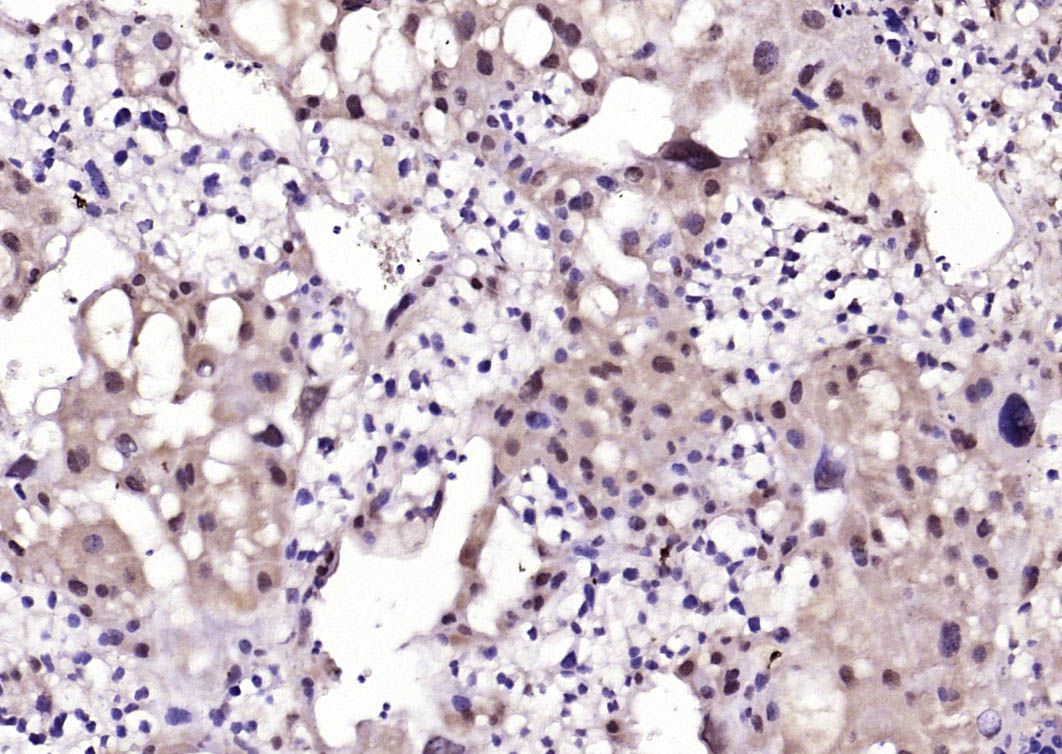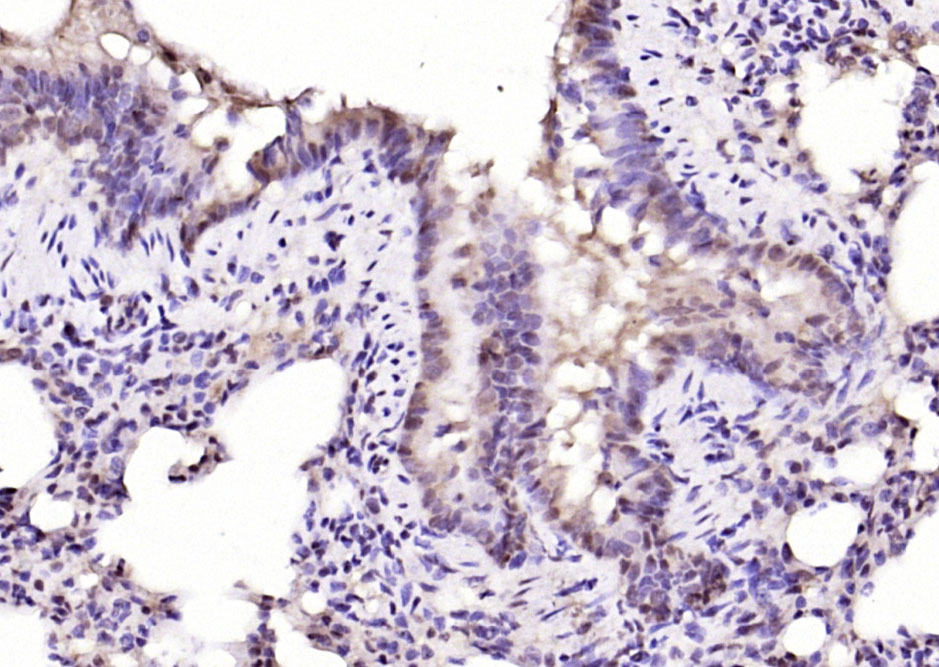
Rabbit Anti-NFATC4 antibody
NF-ATc4; NFATC4 cytoplasmic 4; NF ATc4; NF-AT3; NF-ATc4; NFAC4_HUMAN; NFAT3; NFATc4; Nuclear factor of activated T cells cytoplasmic 4; Nuclear factor of activated T cells cytoplasmic calcineurin dependent 4; Nuclear factor of activated T-cells; nuclear f
View History [Clear]
Details
Product Name NFATC4 Chinese Name T细胞激活核转录因子4抗体 Alias NF-ATc4; NFATC4 cytoplasmic 4; NF ATc4; NF-AT3; NF-ATc4; NFAC4_HUMAN; NFAT3; NFATc4; Nuclear factor of activated T cells cytoplasmic 4; Nuclear factor of activated T cells cytoplasmic calcineurin dependent 4; Nuclear factor of activated T-cells; nuclear factor of activated T-cells cytoplasmic 4; Nuclear factor of activated T-cells cytoplasmic calcineurin-dependent 4; T cell transcription factor NFAT3; T-cell transcription factor NFAT3. literatures Research Area Cell biology immunology Signal transduction lymphocyte t-lymphocyte Epigenetics Immunogen Species Rabbit Clonality Polyclonal React Species Mouse, Rat, (predicted: Human, Dog, Pig, Cow, Horse, Sheep, ) Applications WB=1:500-2000 ELISA=1:5000-10000 IHC-P=1:100-500 IHC-F=1:100-500 IF=1:50-200 (Paraffin sections need antigen repair)
not yet tested in other applications.
optimal dilutions/concentrations should be determined by the end user.Theoretical molecular weight 95kDa Cellular localization The nucleus cytoplasmic Form Liquid Concentration 1mg/ml immunogen KLH conjugated synthetic peptide derived from human NF-ATc4: 475-525/902 Lsotype IgG Purification affinity purified by Protein A Buffer Solution 0.01M TBS(pH7.4) with 1% BSA, 0.03% Proclin300 and 50% Glycerol. Storage Shipped at 4℃. Store at -20 °C for one year. Avoid repeated freeze/thaw cycles. Attention This product as supplied is intended for research use only, not for use in human, therapeutic or diagnostic applications. PubMed PubMed Product Detail The product of this gene is a member of the nuclearfactors of activated T cells DNA-binding transcription complex.This complex consists of at least two components: a preexistingcytosolic component that translocates to the nucleus upon T cellreceptor (TCR) stimulation and an inducible nuclear component.Other members of this family of nuclear factors of activated Tcells also participate in the formation of this complex. Theproduct of this gene plays a role in the inducible expression ofcytokine genes in T cells, especially in the induction of the IL-2and IL-4. Alternatively spliced transcript variants encodingdifferent isoforms have been noted for this gene.
Function:
Plays a role in the inducible expression of cytokine genes in T-cells, especially in the induction of the IL-2 and IL-4. Transcriptionally repressed by estrogen receptors; this inhibition is further enhanced by estrogen. Increases the transcriptional activity of PPARG and has a direct role in adipocyte differentiation. May play an important role in myotube differentiation. May play a critical role in cardiac development and hypertrophy. May play a role in deafferentation-induced apoptosis of sensory neurons.
Subunit:
Member of the multicomponent NFATC transcription complex that consists of at least two components, a pre-existing cytoplasmic component NFATC2 and an inducible nuclear component NFATC1. Other members such as NFATC4, NFATC3 or members of the activating protein-1 family, MAF, GATA4 and Cbp/p300 can also bind the complex. NFATC proteins bind to DNA as monomers. Interacts with CREBBP, GATA4, IRAK1, MAPK8, MAPK9 and RPS6KA3.
Subcellular Location:
Cytoplasm. Nucleus. Cytoplasmic for the phosphorylated form and nuclear after activation that is controlled by calcineurin-mediated dephosphorylation. Rapid nuclear exit of NFATC is thought to be one mechanism by which cells distinguish between sustained and transient calcium signals. The subcellular localization of NFATC plays a key role in the regulation of gene transcription.
Tissue Specificity:
Highly expressed in placenta, lung, kidney, testis and ovary. Weakly expressed in spleen and thymus. Not expressed in peripheral blood lymphocytes. Detected in hippocampus.
Post-translational modifications:
Phosphorylated by NFATC-kinases; dephosphorylated bycalcineurin. Phosphorylated on Ser-168 and Ser-170 by MTOR, IRAK1,MAPK7 and MAPK14, on Ser-213 and Ser-217 by MAPK8 and MAPK9, and onSer-289 and Ser-344 by RPS6KA3. Phosphorylated by GSK3B.
Ubiquitinated, leading to its degradation by the proteasomeand reduced transcriptional activity. Ubiquitination and reductionin transcriptional activity can be further facilitated throughGSK3B-dependent phosphorylation. Polyubiquitin linkage is mainlythrough 'Lys-48'.
Similarity:
Contains 1 IPT/TIG domain.
Contains 1 RHD (Rel-like) domain.
SWISS:
Q14934
Gene ID:
4776
Database links:Entrez Gene: 4776 Human
Entrez Gene: 73181 Mouse
Omim: 602699 Human
SwissProt: Q14934 Human
SwissProt: Q8K120 Mouse
Unigene: 77810 Human
Unigene: 27908 Mouse
Unigene: 23727 Rat
Product Picture
References (0)
No References
Bought notes(bought amounts latest0)
No one bought this product
User Comment(Total0User Comment Num)
- No comment




 +86 571 56623320
+86 571 56623320
 +86 18668110335
+86 18668110335

